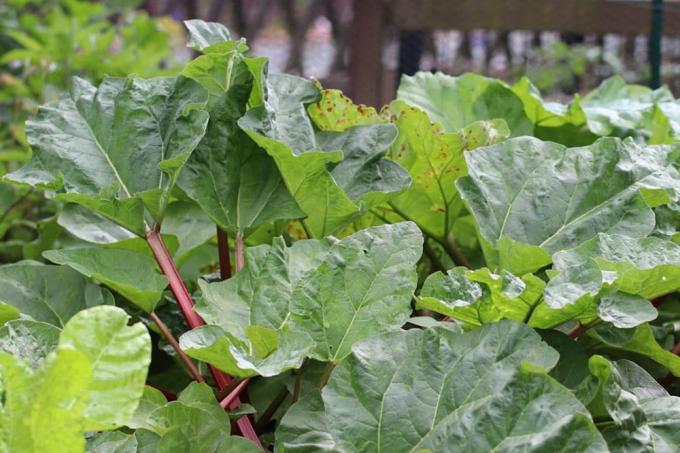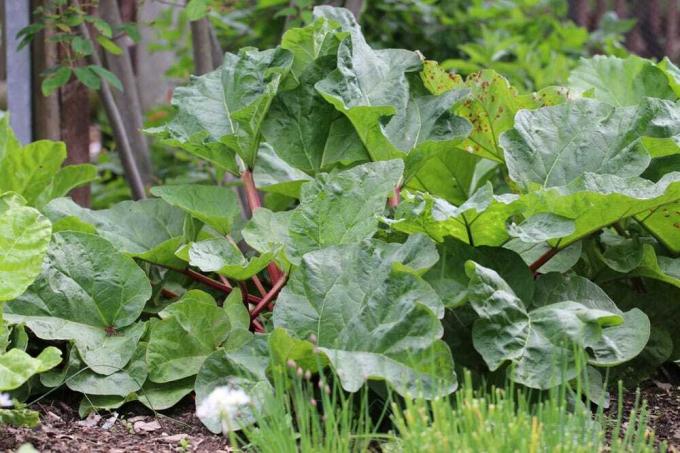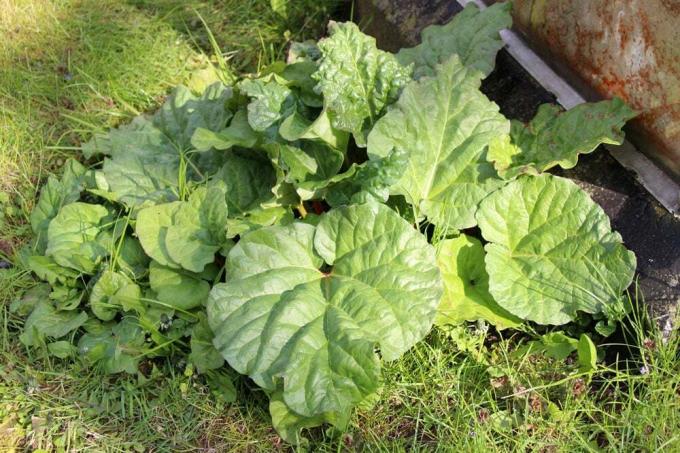

Table of contents
- Fruits or vegetables?
- Useful and poisonous plant parts
- Notes on growing rhubarb
- A vegetable with high ornamental value
- Popular Varieties
- Conclusion
Rhubarb, also known as common, vegetable or curly rhubarb, is a crop from the knotweed family. The Latin name 'Rheuma rhabarberum' means something like 'root of the barbarians' and refers to its region of origin, Tibet. The strong stems are eaten. They can be eaten raw with restrictions, but above all they can be processed into numerous desserts or cakes. Some parts of the plant are poisonous due to the high levels of oxalic acid. But is rhubarb a fruit or a vegetable?
Fruits or vegetables?
Due to the fact that rhubarb is mainly processed into sweet dishes such as compotes, jams, desserts and cakes, it is believed to be closer to fruit than to vegetables. Its somewhat sour taste is also more associated with a type of fruit. An argument for fruit could be that vegetables usually have to be sown or grown every year and fruit grows on perennial plants. Nevertheless, it is undisputed that rhubarb is a perennial plant that, botanically speaking, is clearly a vegetable, even if it can always be found on the supermarket shelf with fruit.
Strictly speaking, rhubarb is a stem vegetable that also includes asparagus, celery and chard. It is not the infructescence that is eaten here, but the stalks, but not the shoot axis. The stalks of stem vegetables usually grow above the ground, have flowers and leaves and are also fleshy and thickened. These are all properties that also apply to rhubarb.
Tip:
If you put a bucket or large clay pot upside down over the plant in early spring, before it sprout, the pale stalks that appear a few weeks later are particularly tender and mild.
Useful and poisonous plant parts
Rhubarb is not only very aromatic, but can also strengthen our immune system because it contains important vitamins, minerals and pectins. The Chinese recognized this around 2,700 years BC. Chr. and henceforth use it as a medicinal plant. Rhubarb season begins in April and ends on St. John's Day, April 24th. June. After that, you shouldn't eat it again. The problem with this plant is the high proportion of oxalic acid, which is harmful to health if consumed in large quantities.

The proportion in the leaves is particularly high, but they are not suitable for consumption anyway. But the stalks also contain oxalic acid and its proportion is slowly but steadily increasing. As a result, consumption after the 24th June discouraged. Until then, the concentration in the stalks is classified as harmless, especially if you are already harvesting in April, when the oxalic acid content is still minimal. In normal quantities, you can eat the refreshing vegetables without hesitation during the best harvest time.
Notes on growing rhubarb
Rhubarb is a so-called permanent crop, it is planted once, can stay in the same place for about 10 years and can be harvested year after year. Under optimal conditions, it increases in size and yield every year.
- Sunny locations and fertile, loose, deep soil are ideal
- Sandy soil enriched with leaf humus is best suited
- Rhubarb shouldn't be in too much shade
- In dark locations, the stems remain very thin
- The space required for a single plant is about one square meter
After the harvest, it is advisable to provide the plants with compost and some mineral fertilizer so that they can go into winter rest well strengthened. From October no maintenance is required. Winter protection can also be dispensed with.
Tip:
Rhubarb can usually be harvested for the first time from the 3rd month of life. standing year.
A vegetable with high ornamental value
The flower buds of the rhubarb are usually broken out in April/May to benefit the stalks. But the flowers in particular have a very high ornamental value and are extremely decorative. It is often said that rhubarb can no longer be eaten during flowering, but this is not proven anywhere.
If you attach particular importance to the filigree and very decorative flowers, it is best to leave two or three flowering shoots. Or you can go straight for a pure ornamental rhubarb, for example the crown rhubarb or Siberian ornamental rhubarb. This impressive decorative perennial grows up to 200 cm in height and enchants with a beautiful red flower from May to July. Their initially green and later reddish leaves and seed pods also have a high ornamental value.
Popular Varieties

Among the 60 or so species of this vegetable plant, there are some varieties that are particularly popular. Green-skinned varieties contain the most acidity. Rhubarb with green flesh and a reddish skin is much milder. The sweetest are varieties with a red skin and red flesh. Which variety of this vegetable you ultimately choose is a question of personal taste.
Edible Rhubarb 'Holsteiner Blood'
The approx. The 60 cm high stalks of this proven, medium-early and very hardy classic are red-stemmed with predominantly greenish to pink-colored flesh. They are remarkably mild in taste. If you break off cream-colored flowers completely, the harvest will be correspondingly higher.
Edible Rhubarb 'Rosa'
This edible rhubarb is also extremely productive. Its stems are up to 40 cm long, have green flesh with a reddish skin and the flowers are cream-colored.
Edible Rhubarb 'Goliath'
Among all edible rhubarb, the 'Goliath' variety is a real giant. The green-fleshed, reddish stems of this high-yielding variety can reach a length of up to 90 cm. They have a slightly sour, strong taste. The cream-colored flowers can be a real eye-catcher in the garden. As with all varieties, the best time to harvest is from April to June.
Raspberry Rhubarb 'Frambozen Rood'
This raspberry rhubarb, also known as rose rhubarb, surprises with an intense, fruity and fresh taste. Its stems are red-skinned with green flesh. They smell pleasantly of raspberries and are so tender that they can also be eaten unpeeled.
Edible Rhubarb 'Red Valentine'
This rhubarb is a breed from Canada with red skin and red flesh. In a particularly warm spring, the stems may remain light-colored. Compared to other varieties, the stems remain comparatively small with a length of 30 cm.
Conclusion
Rhubarb is a somewhat unusual but very aromatic and tasty vegetable. Even if one or the other would rather classify it as fruit, that does not detract from its individuality. Those who cannot get used to the special taste of rhubarb could at least benefit from the attractiveness of its flowers.
 Home editorial office
Home editorial office
Learn more about rhubarb

When and with what to fertilize rhubarb?
Properly prepared, rhubarb is a real treat. However, in order to thrive, it needs sufficient nutrients. The right fertilizer plays an important role in this.

Rhubarb location: 4 important criteria
Rhubarb, which is related to sorrel, is a fruity, sour stem vegetable that can be harvested from around April. It is hardy, extremely easy to care for and needs a new location every few years. The harvest season traditionally ends on St. John's Day, the 24th. June.

How deep is rhubarb rooted? | Root depth information
How deep is rhubarb rooted? Everyone who wants to implement the plant must ask themselves this question. Because the dimensions are important both for digging up the plant and for digging the new planting hole. Here is the answer.

Pruning rhubarb after harvest - how is it pruned?
Rhubarb - which is actually a vegetable - is a popular topping for cakes and tasty as a compote. As a garden plant, however, it poses many a puzzle. This includes the cut. Interested parties can find out when it makes sense and when not.

Transplanting rhubarb | the best time to plant | planting time
Fruity, juicy and full of vitamins - if you plant rhubarb in your garden, you always have an aromatic vegetable at hand for summer desserts or cakes. But when cultivating the popular vegetable, it should be borne in mind that the delicious sticks need to be moved from time to time in order to produce a rich harvest.

Cooking rhubarb jam - basic recipe
Rhubarb, a wonderfully old-fashioned vegetable, is back in fashion, at least in the kitchen. There are now different breeds with green or red flesh and they grow almost by themselves in the garden. Until the 24th It should be harvested and processed by June. The classic is rhubarb jam, and with good reason.

